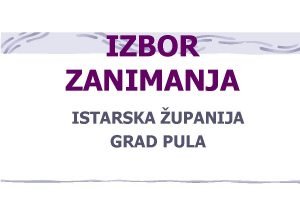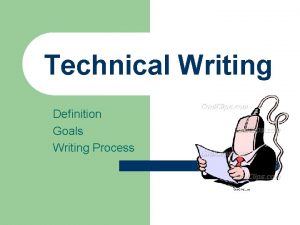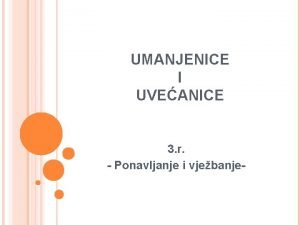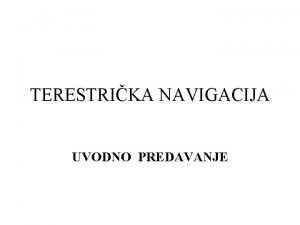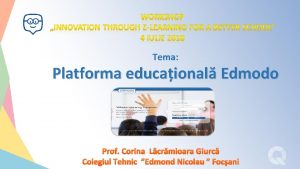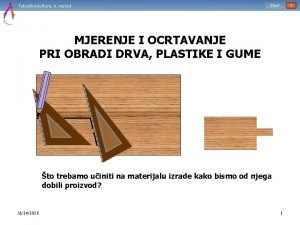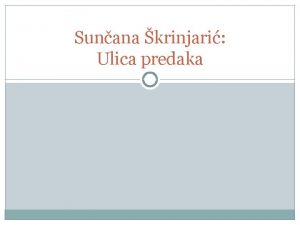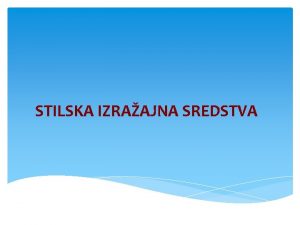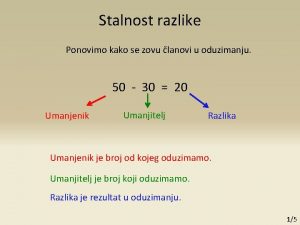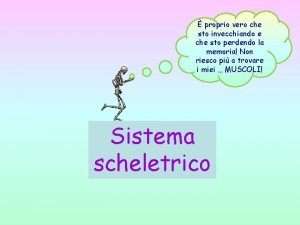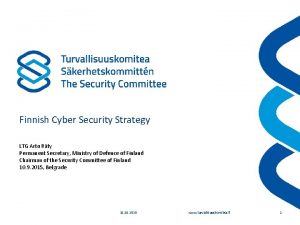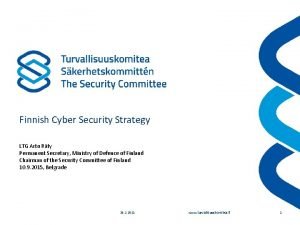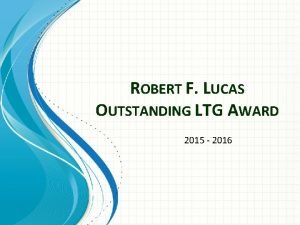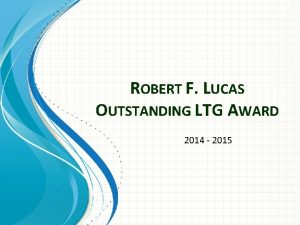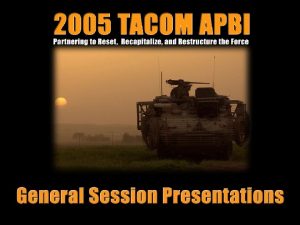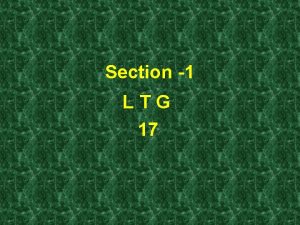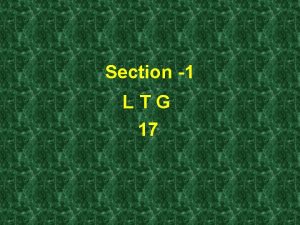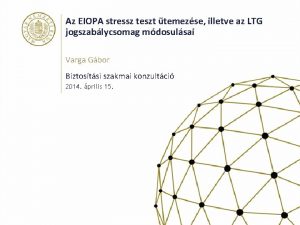GOAL WRITING Agenda Goal Writing LTG vs STO



















- Slides: 19

GOAL WRITING

Agenda Goal Writing LTG vs STO SMART acronym Types Color coded template Practice

Goal Writing Why do we write goals/objectives? What is important to include in a goal? Who has seen poorly written goals? What was wrong with them?

LTG vs. STO Goal/LTG: overall statement of targeted behavior Goals are dependent on the setting in which the client is served or expected to accomplish the goal Most IEP/IFSP goals written for EC CARES or the school district will be for one year Goals written for the clinic may be for one-term or longer, depending on the needs of the client Objectives/STO: task anaylsis; small steps to achieve the goal; small steps to monitor progress Can be sequential or additive

Goal with Sequential Objectives SS will produce target sounds (k, g, s, s-blends) in conversation with 80% accuracy over 2 consecutive sessions. 1. Given cues and prompts, SS will correctly produce target sounds (k, g, s, sblends) in isolation in 8 out of 10 trials over two consecutive sessions. 2. Given cues and prompts, SS will correctly produce target sounds (k, g, s, sblends) in words 8 out of 10 trials over two consecutive sessions. 3. Without cues or prompts, SS will independently produce target sounds (k, g, s, sblends) in words correctly in 8 out of 10 trials over two consecutive sessions. 4. Given diminishing cues, SS will independently produce target sounds (k, g, s, sblends) in phrases in 8 out of 10 trials over 2 consecutive sessions. 5. Given diminishing cues, SS will independently produce accurate target sounds (k, g, s, s-blends) in sentences in 8 out of 10 trials over 2 consecutive sessions.

Goal with Additive Objectives FT demonstrate increased utterance length my maintaining an average of 3 -word utterances (MLU=3. 0) across settings (classroom, home) as measured by 2 language samples (50 utterances minimum). 1. FT will routinely say at least 50 nouns (family members, animals, toys) as measured by the Mac. Arthur-Bates Communicative Inventories (CDI). 2. FT will routinely say at least 10 action words (e. g. , “want”, “go”, “run”) as measured by the CDI. 3. FT will routinely say at least 3 pronouns (e. g. , “I”, “me”, “you”) as measured by the CDI.

Writing SMART goals/objectives Specific Measureable Attainable Routine-Based Tied to Functional Priority Jung, L. A. (1997). Writing SMART objectives and strategies that fit the ROUTINE. Teaching Exceptional Children, 39, p 54 -58.

Specific Goals & Objectives Goals should be written so that everyone involved with the client can understand the target behavior Specific terms for how client will reach the goal (supports, prompts, cues required for independent success) Which is better and why? DC will communicate better DC will indicate her preferred activity, interaction, or object by using a sign or word When given a choice of two during familiar daily routines, DC will imitate a word or use a sign to indicate her preferred activity, interaction, or object. Mc. William, R. A. , Ferguson, A. , Harbin, G. . Porter, D. M. , & Vaderviere, P. (1998). The family-centeredness of individualized family services plans. Topics in Early Childhood Special Education, 18. 69 -82.

Measurable Goals and Objectives should be… Quantifiable, observable, describable Measurable Which is better and why? AR will say bilabial sounds (m, b, and p) in all positions of words with 80% accuracy. AR will improve her ability to say bilabial sounds (m, b, and p).

Things to consider… If someone else measures, will they get the same results? (reliability) Who is going to measure? Will the person measuring be able to do the measurement as stated without disrupting routine or without undue burden? Have you dictated a specific strategy or procedure? Forcing clinician to DO it your way?

Verbs that refer to measurable behaviors Word or Sound Production Use strategy Produce Retell Name Write Rhyme Blend Describe Say Repeat Recall Ask Request Comment Word or concept comprehension Point Identify Sort Match Place/Put Look S. M. Meyer. (1998) Survival guide for the beginning speech-language clinician. Aspen Publication: Gaithersburg, MD.

Verbs not measurable Understand Think Learn Improve Know Remember Comprehend Discover Demonstrate

Attainable Goals & Objectives IFSP/IEP goals are typically written for 1 year, but objectives should be easy for the child to achieve within 2 to 4 months, so children and families can celebrate success & receive positive progress reports. Parents or other team members might suggest a long -term goal, your job is to break it down into achievable objectives. Baseline data is used to determine where to begin. Client response to treatment might suggest how objectives should be organized Jung, L. A. , Gomez, C, & Baird, S. M. (2003). Family-centered intervention: Bridging the gap between IFSPs and implementation. In E. Horn, M. M. Ostrosky, & H. Jones (Eds. ), Young Exceptional Children Monograph Series No. 5: Family-Based Practices [pp. 61 - 76). Longmont, CO: Sopris West Educational Services.

Zone of Proximal Development Vygotsky, L. (1978). Interaction between Learning and Development (pp. 79 -91). In Mind in Society. (Trans. M. Cole). Cambridge, MA: Harvard University Press.

Routine-Based Goals & Objectives Goals should be written to increase the child’s success in the context of daily routines & activities Functional, meaningful Example?

Tied to a Functional Priority Client needs/beliefs/values (EBP pillar) Goals should be derived from family members & other team members based on needs/preferences Goals should not be derived from standardized tests Which is better and why? SD will imitate verb+ing (such as “walking” “going”) with 80% accuracy over two sessions. SD will imitate verb+ing (such as “walking” “going”) with 80% accuracy in family and school settings to describe actual events.

Color coding Given (context) XX will improve (domain change) By (doing what specific behavior? ) with (x/10, %) accuracy (or by sustaining behavior for durations or intervals) in (acad, functional, community) settings in the presence of (high to low) cues across (2 -3) sessions (? consecutive) as measured by (clin, obs, tchr)

Long Term Goal (LTG) 1: Tt will demonstrate improvements in attention and working memory to improve his ability to pursue desired activities including reading and cooking. Short Term Objective (STO) 1. 1: Tt will complete three forty-minute sessions per week of Attention Process Training exercises targeting working memory, sustained attention, and selective attention. His accuracy and response time will improve by a minimum of 20% on all exercises over two consecutive sessions while maintaining a level-of-effort rating at 3 or above. STO 1. 2 Tt, in conjunction with his wife, will keep a written log providing reports of weekly attention lapses and successes. Improvements in attention will be demonstrated by decreased lapses and increased successes.

Long Term Goal (LTG) 1. 0: Mm will use metacognitive strategies to improve memory for past events and the tracking of personal belongings. Short Term Objective (STO) 1. 1: Mm and the clinician will collaboratively identify strategies to help Mm reduce instances of misplaced personal belongings. Mm will demonstrate independent use of strategy steps in the clinic. STO 1. 2: Mm will independently use an orienting strategy (“stop and think”) at least twice daily to reinforce time-based or episodic memories and reduce reported loss of memory for past experiences to no more than one per week for two consecutive weeks as based on spouse and “forgetting logs. ” STO 1. 3: Mm will independently use a self-instructional strategy (“What was I just doing? … Where am I going next? ”) during physical transitions between locations to reduce instances of lost or forgotten personal belongings to less than one time a week for two consecutive weeks as reported in spouse and “forgetting logs. ”
 Googlr znalac
Googlr znalac Zvanje i zanimanje
Zvanje i zanimanje Agenda sistemica y agenda institucional
Agenda sistemica y agenda institucional What is the purpose of narrative paragraph
What is the purpose of narrative paragraph Unit 1
Unit 1 Nbcot domains
Nbcot domains Teknikal na salita
Teknikal na salita Nezasitnost i bijeda tema
Nezasitnost i bijeda tema Ustanove
Ustanove šta su umanjenice
šta su umanjenice Uvecanica i umanjenice
Uvecanica i umanjenice Kolnička traka
Kolnička traka Sto je azimut broda
Sto je azimut broda Sto clase virtuale
Sto clase virtuale što je ocrtavanje
što je ocrtavanje Rijecne terase
Rijecne terase Socijalna karakterizacija
Socijalna karakterizacija Stilska izražajna sredstva ponavljanje
Stilska izražajna sredstva ponavljanje Opkoracenje
Opkoracenje Stalnost razlike zadaci
Stalnost razlike zadaci

